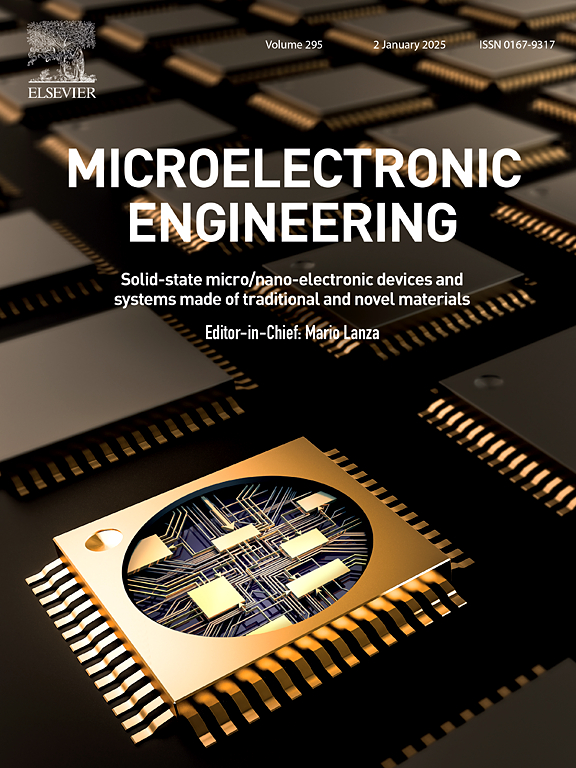Low temperature solid-state diffusion bonding of fine pitch Cu/Sn micro-bumps assisted with formic acid vapor for 3D integration
IF 3.1
4区 工程技术
Q2 ENGINEERING, ELECTRICAL & ELECTRONIC
引用次数: 0
Abstract
Low-temperature solid-state diffusion (SSD) bonding of 5 μm diameter Cu/Sn micro-bumps was achieved with the assistance of formic acid vapor. Efforts were made to overcome surface oxidation of copper and uneven tin morphology, which are two major challenges in SSD bonding. Formic acid vapor was used as pre-treatment gas before bonding and protection gas during bonding. The results demonstrated that formic acid vapor is highly effective in removing surface oxidation on copper and preventing secondary oxidation, thereby facilitating a strong bond. Temperatures of 160 °C and 200 °C in 120 s were identified as ideal for pre-treatment. In SSD thermal compression bonding, 30 MPa TCB pressure was found to be necessary to overcome the uneven tin morphology. Other bonding parameters were also optimized, achieving a die shear strength of up to 59 MPa while reducing bonding temperature and time to 150 °C and 10 min. As bump scale shrinks, the interface analysis revealed a unique “teeth-like” structure in the bonding interface, contributing to improved shear strength due to intermetallic compound (IMC) growth and a favorable stress distribution. The assistance of formic acid vapor and the optimization of bonding parameters enhances the likelihood of future applications of solid-state bonding in industry, which could be an alternative choice for fine-pitch micro-bump bonding application.

甲酸蒸气辅助下细间距Cu/Sn微凸点的低温扩散键合
在甲酸蒸气的辅助下,实现了5 μm直径的Cu/Sn微凸起的低温固态扩散键合。努力克服铜的表面氧化和锡的不均匀形貌,这是SSD键合的两个主要挑战。采用甲酸蒸汽作为粘接前的预处理气体和粘接时的保护气体。结果表明,甲酸蒸气能有效去除铜表面氧化,防止二次氧化,从而促进铜的牢固结合。160°C和200°C 120 s的温度被确定为理想的预处理温度。在SSD热压缩键合中,为了克服不均匀的锡形貌,需要30 MPa的TCB压力。优化了其他键合参数,在将键合温度和时间降低到150°C和10 min的同时,实现了高达59 MPa的模具剪切强度。随着凹凸垢的缩小,界面分析显示,键合界面中存在独特的“齿状”结构,由于金属间化合物(IMC)的生长和良好的应力分布,有助于提高剪切强度。甲酸蒸气的辅助和键合参数的优化提高了固态键合在工业上应用的可能性,这可能是细间距微碰撞键合应用的另一种选择。
本文章由计算机程序翻译,如有差异,请以英文原文为准。
求助全文
约1分钟内获得全文
求助全文
来源期刊

Microelectronic Engineering
工程技术-工程:电子与电气
CiteScore
5.30
自引率
4.30%
发文量
131
审稿时长
29 days
期刊介绍:
Microelectronic Engineering is the premier nanoprocessing, and nanotechnology journal focusing on fabrication of electronic, photonic, bioelectronic, electromechanic and fluidic devices and systems, and their applications in the broad areas of electronics, photonics, energy, life sciences, and environment. It covers also the expanding interdisciplinary field of "more than Moore" and "beyond Moore" integrated nanoelectronics / photonics and micro-/nano-/bio-systems. Through its unique mixture of peer-reviewed articles, reviews, accelerated publications, short and Technical notes, and the latest research news on key developments, Microelectronic Engineering provides comprehensive coverage of this exciting, interdisciplinary and dynamic new field for researchers in academia and professionals in industry.
 求助内容:
求助内容: 应助结果提醒方式:
应助结果提醒方式:


